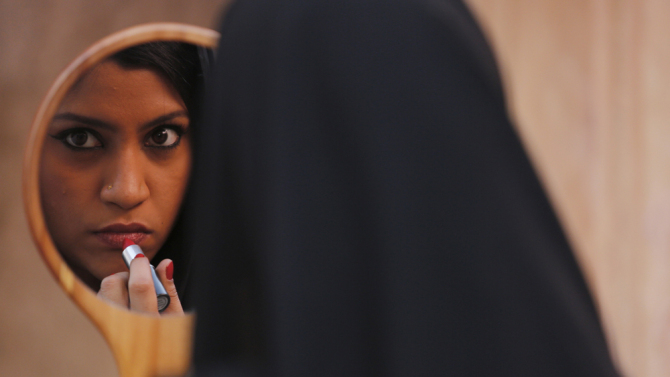The best part of Olu (Her) is perhaps how it begins. The opening sequence goes from an abstract metaphysical space beyond time to nighttime shots of a human-less expanse of backwaters sprinkled with mangroves and ends in a scene of murder carried out by four men. It unfolds like a summary of the earth’s journey so far.
This good feeling, though, doesn’t last. The narrative takes a steep dive into a different zone where everything plays out in loud and broad strokes. Olu, directed by veteran cinematographer-filmmaker Shaji N Karun, is a half-hearted arthouse film. Images are sometimes beautifully unhurried, and sometimes too sparse to say anything significant. In brief instances, the film communicates through a brilliantly designed natural soundscape (sound designed T Krishnanunni) or the subtle and powerful background score (Issac Thomas Kottukapally), but for the most part, it is artlessly verbose and loud. A large number of shots involve the central character, an artist, thinking or staring blankly as he goes through bouts of creative frustration and depression. But there is no scope for empathy as the film and its characters are deeply buried under many layers of soulless posturing. Karun’s aesthetics, this time, are torn between a compulsive urge to stay anti-mainstream and an ambition to be friendly to the audience of commercial cinema.
While Shaji N Karun isn’t new to the physical setting of the film – the backwater lagoons and island villages where the sky is perennially overcast, evoking a sense of foreboding, are reminiscent of the filmmaker’s Kutty Srank – one of the central themes isn’t something he has tried before. Vasu (Shane Nigam) is a young artist who wants to create an original work – a masterpiece – although all he has done in his life is replicate famous paintings. His father is displeased with his decision to veer off the family’s traditional occupation. His sister, Manasi (Kani Kusruti), is mentally ill. His grandmother, an exorcist, believes that the woman’s deranged mind is a result of the curses of spirits that befell the family for years. Karun follows him as Vasu dispassionately participates in the family’s business of guarding an ancient temple and its mythology, and later, struggles to find belongingness and identity in a largely money-minded world outside this remote village. This realistic idea is blended with elements of fantasy, to make a larger commentary about human nature.
The narrative, when stripped to the bone, is made of an old moral tale. An artist looking for inspiration meets a feminine spirit who offers to help him. In return, she demands platonic love and loyalty. But can human instincts be canceled on demand? Greed, lust, and selfishness creep into their placid young love, and a tragedy follows.
Vasu comes across Maya (Esther Anil), the spirit of an adolescent rape victim who’s lodged in a phantasmagorical space in the bottom of the lake amidst a thick growth of water lily, during one of his nocturnal boat-rides through the lake. The writing in this part is awkwardly shallow, with a stage-quality that feels too primitive in this era. We know when Maya and Vasu fall in love because, “Let’s fall in love!” she says, robbing the word off all its emotions. When the film shifts to Mumbai, to the world of corporate art agents and women whose idea of love is the opposite of what Maya represents, the writing becomes weaker, and the narrative turns into an empty virtue signalling exercise.
Strangely, the film doesn’t properly capitalise on the elements of mysticism and mystery in the love story of Maya and Vasu. Could Vasu have been hallucinating or is Maya a part of the village’s reality? After every nocturnal rendezvous with Maya, he wakes up on his boat moored near the temple. Before the audience can think and form an opinion, the film intervenes. From the flower seller next-door to his garrulous grandmother, everyone around Vasu fondly talks of Maya as a regular girlfriend, thus reducing her into a non-mystery. There is an associated track of a Buddhist cult arriving in the village to claim the temple as a part of their history. The red robes, monasteries and religious imageries bring on board merely add to the film’s surface gloss.
There is something about Shane Nigam’s onscreen persona that makes him an easy candidate to play characters who’re conflicted or dispassionate about life. Vasu isn’t a likable character. Neither he nor the people around him are sure about his talents as an artist. The actor makes it believable when the young man goes into the self-destruction zone. There is little emotion in Esther Anil’s hyperbolic performance as a goddess looking for love. The young actress is a painful misfit in Olu, turning the romantic track weaker than what it is conceived to be.
Recommended
The film feels obsolete. The paucity of resources hits the film’s ambitions hard, and it shows. The production does look low-cost. But more than that, it is the film’s refusal to open its mind and subvert ideas on morality and conventions that make it look outdated. It is less interested in trying to understand human condition than in judging human beings for the choices they make in life. The film looks at people from a religious point of view, relegating them to heaven or hell for their capacity to keep human instincts in check. And there is a call to return home. “Your art is so oriental!” exclaims a journalist to Vasu on seeing his painting. At a time when the industry is teeming with mainstream films that use Western storytelling mechanisms to narrate home-grown stories, Olu might be a local auteur’s search for inspiration in native symbols and mythology, to announce to the world what is really ‘home-grown’ art. But what is art worth if it doesn’t liberate the artist?
The Olu review is a Silverscreen original article. It was not paid for or commissioned by anyone associated with the film. Silverscreen.in and its writers do not have any commercial relationship with movies that are reviewed on the site.



